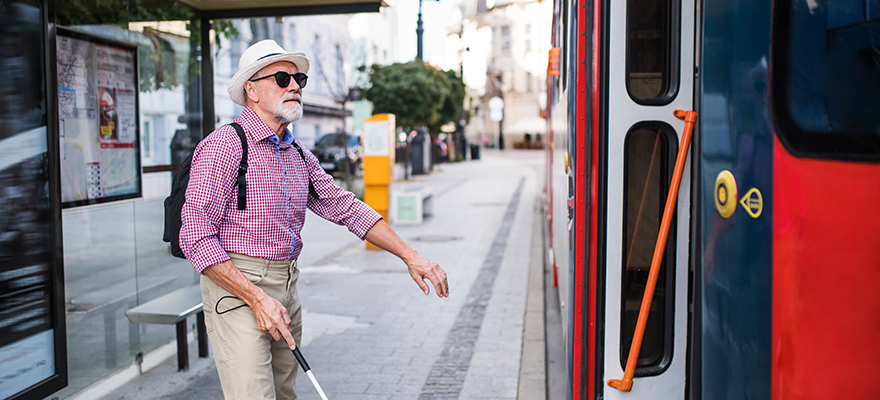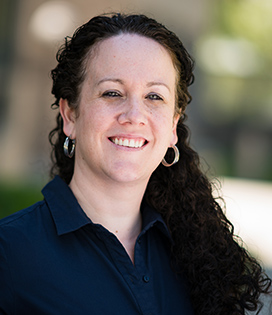Easing barriers in daily life for older adults with vision loss

By Kim McCready
What started as a challenge to identify a less-familiar research topic during work on her master’s degree led Colleen McGrath, now a professor at Western’s School of Occupational Therapy, to dedicate her academic career to exploring vision loss in older adults. From the outset, she was captivated by the creativity and resourcefulness of older adults experiencing age-related vision loss (ARVL) as they navigated their circumstances and surroundings.
“The ingenious strategies that people use to make their occupational lives a little bit easier motivated me to really delve into this research area,” McGrath said. “And I just loved it. I was excited by my findings and that fueled my PhD and all my research since then.”
With the passing of years, ARVL can cast a significant shadow over daily routines, social connections and an individual’s sense of security. Unfortunately, major eye diseases, such as macular degeneration, glaucoma and diabetic retinopathy, that commonly contribute to vision loss, are also linked to aging.

Colleen McGrath, School of Occupational Therapy
Released in 2021, the Cost of Vision Loss and Blindness in Canada Report underlined the scope of the challenge. When the report was released, 1.2 million Canadians were grappling with vision loss, a count anticipated to surge twofold by 2050. Surpassing age 45, the likelihood of vision loss increases substantially, with those aged 85 or older having a prevalence rate of roughly 21 per cent.
McGrath’s research recognizes that both physiological impairment and environmental obstacles affect the ability of older adults with ARVL to fully participate in their occupational goals, impacting their self-esteem and quality of life.
Her work also sheds light on the daily struggles faced by older adults with ARVL and identifies strategies to address these challenges. This includes how they decide whether to adopt assistive technologies (AT) or not and the social changes that can create more inclusive environments and foster increased community mobility.
“People want to portray themselves as independent and self-reliant," McGrath said. "So, when an AT device doesn't fit the notion of how a person wants to present themselves, it greatly influences whether they adopt it or not."
Assistive technologies encompass a broad range of tools and strategies beyond conventional devices, such as rubber bands on pill bottles to differentiate medicines, screen reading software, or even dark sunglasses.
The iconic white cane, for instance, not only aids in navigation but is profoundly symbolic of vision loss and blindness. Despite its practical benefits some individuals, driven by concerns about appearing disabled or a fear of making themselves vulnerable, opt not to use it.
Opting out of using certain technologies can amplify an individual's struggle for independence. Uncovering the underlying motivations behind these choices paves the way for AT designs that are not only effective but also align with users' preferences, ensuring they reap the intended benefits.
AT devices alone are not enough to mitigate many of the impacts of ARVL on an individual’s participation in everyday life and occupation. Barriers to community mobility compound these difficulties, limiting the individual's ability to engage in daily activities, social interactions and access essential services. Awareness of these challenges led McGrath to expand her program of research to include the built environment and community design.
“If we improve our environments in a way that makes individuals feel safe, included and able to go out and accomplish their occupational goals - that would be the dream come true.”
“Often, we set up spaces and later bring in individuals with disabilities to get their feedback on how well things work. They list what doesn't work for them, and then we hear from the developers that it's too costly to make changes now,” McGrath said. “Just imagine if we involve those same individuals right from the beginning. We can design spaces while making sure inclusivity is the focus from day one.”
Consider the example of a crosswalk – traditional approaches concentrate on an individual's physical ability to navigate the crossing within a set timeframe. Her works examines why certain crosswalk designs impede mobility for those facing challenges, why audible signals fall short and why some intersections are simply devoid of them?
“We create environments in a very ableist way, and I think we're missing a real need,” McGrath said. “If we can create spaces to be more universally accessible, there’s potential for a greater positive impact for everyone.”
McGrath and her research team work as a collective using critical Participatory Action Research (PAR). They conduct research with study participants rather than merely about or for them. By involving participants in identifying problems and designing interventions, their research findings are more likely to result in practical, effective and sustainable solutions that can be applied in the real world.
“The collective includes researchers, study participants who are older adults with ARVL, community representatives, city policymakers and blind or partially-sighted students whenever feasible,” she said. “Together, the collective guides our research process.”
In carrying out studies, research assistants join participants on a ‘go-along’ as they navigate neighbourhoods, collecting data and documenting challenges using photographs and video. For the participants, video has been particularly effective in conveying their experiences by demonstrating navigation strategies, offering an animated depiction of their daily routines and providing a clearer view of their circumstances.
The intention is to use these visual insights, along with policy briefs, written reports and infographics as compelling tools to advocate for improvements in urban infrastructure and accessibility. This approach bridges the gap between the experiences of the participants and the decision-makers who have the capacity to enact meaningful change.
McGrath envisions a future where community environments are designed for safety and empowerment. She explains that it’s not uncommon for people, particularly those with vision loss, to have to make decisions prioritizing which of their potential activities are necessary, which can lead to staying isolated at home. These decisions, unfamiliar to many, entail sacrificing meaningful experiences. Activities that add value to life, are forgone.
“If we improve our environments in a way that makes individuals feel safe, included and able to go out and accomplish their occupational goals - that would be the dream come true,” McGrath explained.

